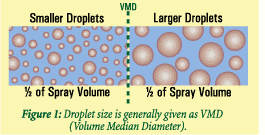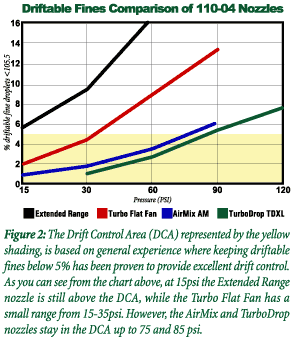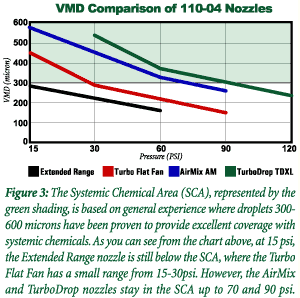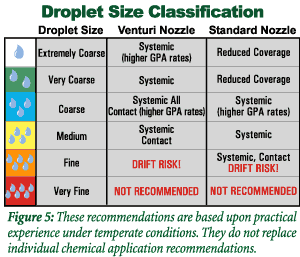Droplet Size, Driftable Fines Classification Schemes
 The spray cloud produced from a given spray nozzle usually consists of a wide variety of droplet sizes. VMD or Volume Median Diameter is one way to describe the droplet size range. The VMD is the average droplet size by volume of the spray cloud. For example, a spray nozzle producing a VMD of 400 micron might actually produce a small number of droplets much larger than 400 micron and a large number of droplets smaller than 400 micron. The 400 micron VMD simply indicates that half the volume of the spray is in droplets smaller than 400 micron and half the volume in droplets larger than 400 micron (Figure 1).
The spray cloud produced from a given spray nozzle usually consists of a wide variety of droplet sizes. VMD or Volume Median Diameter is one way to describe the droplet size range. The VMD is the average droplet size by volume of the spray cloud. For example, a spray nozzle producing a VMD of 400 micron might actually produce a small number of droplets much larger than 400 micron and a large number of droplets smaller than 400 micron. The 400 micron VMD simply indicates that half the volume of the spray is in droplets smaller than 400 micron and half the volume in droplets larger than 400 micron (Figure 1).
 The VMD actually tells very little about the amount of drift a spray nozzle will produce at a given pressure. A more useful measurement is the percentage of driftable fines, or the volume of the spray that is made up of droplets smaller than a certain size. In Figure 2, the droplets smaller than 105.5 micron are considered driftable fines. As pressure is increased or as nozzle size decreases, the volume of small driftable droplets increases. The increase in driftable fines is much more gradual with Venturi nozzles, giving them a wider effective pressure range.
The VMD actually tells very little about the amount of drift a spray nozzle will produce at a given pressure. A more useful measurement is the percentage of driftable fines, or the volume of the spray that is made up of droplets smaller than a certain size. In Figure 2, the droplets smaller than 105.5 micron are considered driftable fines. As pressure is increased or as nozzle size decreases, the volume of small driftable droplets increases. The increase in driftable fines is much more gradual with Venturi nozzles, giving them a wider effective pressure range.
Balancing Drift Control and Coverage
Spraying agricultural chemicals requires balancing drift control and coverage. Some chemicals require more complete coverage for acceptable efficacy. While 300-600 micron should be adequate for most systemic products like glyphosate (Figure 3), contact chemicals may require a VMD in a smaller range. For our Venturi nozzles, targeting 300-400 micron for these coverage-critical applications has proven effective in the field. In general, a 40 psi minimum pressure with the AirMix® AM and a 60 psi minimum pressure with the TurboDrop® TDXL is a good rule of thumb for contact chemicals.
 Droplet Classification Systems
Droplet Classification Systems
The American Society of Agricultural Engineers (ASAE) and the British Crop Protection Council (BCPC) currently classify sprays into six different categories, based on the range of droplet size at a given spray pressure. Chemical manufacturers are beginning to recommend drop size categories for specific chemicals in order to maximize efficacy and/or minimize off target movement. Some states are also using this classification system to regulate spray applications.
As pressure increases with a given spray nozzle, the droplet size category may change (ASAE Droplet Size Classification). For example, at 32 psi the TDXL11004 goes from an extremely coarse to a very coarse spray. From 46 psi to 65 psi, the TDXL11004 produces a coarse spectrum, and from 65 to 120 psi, it produces a medium spray droplet spectrum. The appropriate drop size category should be matched to the application.
 Conventional vs. Venturi Nozzles
Conventional vs. Venturi Nozzles
Field experience has shown that the air filled droplets produced by Venturi nozzles usually allow for a somewhat coarser (more drift resistant) spray than would be tolerated with a standard nozzle, without reducing efficacy. In other words, where a Medium drop size might be required with a standard nozzle, a Coarse drop size would be sufficient with a Venturi nozzle (Figure 5).
For each application, maximizing the number of droplets in the most effective drop size range is the goal. With this in mind, TurboDrop® and AirMix® nozzles produce a narrower drop size spectrum, with fewer driftable fines as well as fewer extremely large, ineffective droplets. In other words, these Venturi nozzles are designed to reduce drift without sacrificing coverage. As mentioned previously, for coverage critical applications, especially in dense canopies, higher pressures are recommended.
